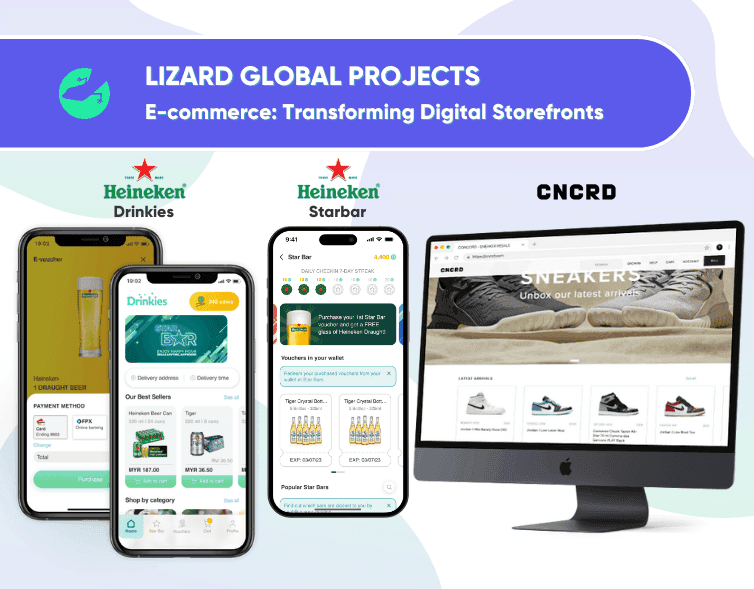Why Choose Next.js for Web Development Apps?
21 Dec 2023
by Asrul Ash, Content Writer
21 Dec 2023
by Asrul Ash, Content Writer
Why Choose Next.js for Web Development Apps?
Table of contents
Contact us
We will get back to you in the next 48 hours.

Why Choose Next.js for Web Development Apps
What is Next.js, and how does it differ from traditional React applications? What are the key features of Next.js that make it suitable for building powerful web apps?
Follow Lizard Global on Facebook, Instagram, and LinkedIn.
Developing systems that are both scalable and performant demands tools that not only increase productivity in the ever-changing web development market but also offer reliable solutions. One such tool that has gained immense popularity in the React ecosystem is Next.js. In this post, we'll explore the essence of Next.js, its advantages over traditional React applications, and why it stands out as a powerful framework for web app development.
</> What is Next.js?
Next.js represents a significant evolution in the React ecosystem, introducing a framework that goes beyond the capabilities of vanilla React. At its core, Next.js is designed to augment the development experience and performance of web applications. While React traditionally focuses on the client side—meaning that the rendering process occurs in the user's browser—Next.js takes a revolutionary step forward by introducing server-side rendering (SSR), automatic code splitting, and other advanced features.
Extending React's capabilities
React, with its declarative and component-based approach, has revolutionized how developers build user interfaces. However, as web applications grow in complexity, certain challenges arise, particularly in terms of initial page load times and search engine optimization (SEO). Next.js addresses these challenges head-on, providing a holistic solution that enhances both the developer workflow and the end-user experience.
🧐 How does it differ from traditional React applications?
The key differentiator lies in Next.js' seamless integration of server-side rendering. In a traditional React application, the rendering process predominantly occurs on the client side. While this approach is effective, it can lead to slower initial page loads, especially for content-rich applications, and may pose challenges for search engine optimization.
Next.js addresses these drawbacks by offloading a portion of the rendering process to the server. This means that, instead of relying solely on the client to generate the page content, Next.js servers pre-render pages, delivering a fully formed HTML page to the user's browser. The result is a notable improvement in load times and enhanced search engine visibility, as search engines can more effectively index server-rendered content.
🤩 Why choose Next.js for your Web Development projects?
Choosing the right framework can significantly impact the success of your projects. Next.js, an extension of React, stands out as a compelling choice for various reasons, each contributing to an enhanced development experience and improved outcomes for web applications.
1. Faster page loads
At the forefront of reasons to opt for Next.js is the substantial improvement it brings to application performance. Leveraging server-side rendering (SSR), Next.js shifts the rendering process from the client to the server, resulting in faster page loads. This optimization is particularly impactful for content-rich applications, as users experience quicker access to fully rendered pages. The enhanced performance not only contributes to a smoother user experience but also addresses the challenges associated with sluggish initial page loads.
2. Better navigation of search engines
Search engine optimization (SEO) is paramount for a web application's success, especially in the contemporary digital landscape. Next.js excels in this regard by seamlessly incorporating server-side rendering. Traditional React applications, relying heavily on client-side rendering, may encounter challenges with SEO as search engines struggle to crawl and index dynamic content effectively. Next.js, with its SSR capabilities, ensures that search engines can easily navigate and understand the content of your application. The result is improved visibility, higher rankings, and an overall stronger SEO foundation for Next.js applications.
3. Intuitive API and file-based routing system
Next.js doesn't just excel in performance and SEO; it also prioritizes a developer-friendly experience. Its intuitive API and file-based routing system significantly simplify the development process. Developers can focus on building features rather than grappling with complex configurations. The framework's streamlined approach makes it an ideal choice for projects of all sizes, from small applications to large-scale enterprise solutions. This simplicity not only accelerates development but also contributes to code maintainability and collaboration within development teams.
🔥 Looking for the fastest way to calculate app development costs? Get a realistic estimate of your web & mobile app development project with our App Cost Estimator. Totally FREE! Click, calculate, and get ready for the appventure of a lifetime.
🏆 What are the key features of Next.js that make it suitable for building powerful web apps?
As the demands on web applications continue to evolve, developers seek frameworks that not only keep pace but also provide advanced features to enhance performance and flexibility. Next.js, building upon React's foundation, introduces key features that distinguish it as a robust framework for building powerful web applications. Let's explore some of these pivotal features that set Next.js apart.
1. Automatic code splitting
Next.js leverages automatic code splitting, a powerful optimization technique that transforms the way JavaScript is loaded in web applications. Instead of bundling the entire application's JavaScript code into a single file, Next.js intelligently divides the code into smaller, more manageable chunks. Each page receives only the JavaScript it needs, resulting in smaller initial bundles. This not only improves load times but is especially advantageous for larger applications where minimizing the initial payload is crucial for a responsive user experience.
2. Server-side rendering (SSR)
One of the standout features of Next.js is its seamless integration of server-side rendering (SSR). In traditional React applications, rendering primarily occurs on the client side, leading to potential performance bottlenecks and SEO challenges. Next.js addresses this by enabling the server to handle the initial rendering. The server sends a fully rendered HTML page to the client, significantly reducing the time it takes for users to see content. This not only enhances performance by mitigating client-side rendering delays but also ensures superior search engine visibility. SSR proves to be a game-changer, particularly for content-rich applications where timely content delivery is paramount.
3. Data fetching methods and API routes
Next.js offers developers a versatile set of data fetching methods, providing flexibility to choose the best approach based on the application's requirements. Whether opting for static site generation, server-side rendering, or client-side rendering, developers can tailor their data fetching strategies accordingly. Additionally, Next.js includes API routes, allowing developers to build serverless functions seamlessly within their applications. This abstraction simplifies backend development, enabling the creation of robust APIs without the need for an external server. The combination of data fetching methods and API routes empowers developers to craft efficient and performant web applications with ease.

🔥 Best practices for optimizing performance in Next.js applications
In web development, optimizing performance is not just a goal but a crucial necessity. Next.js, with its focus on speed and efficiency, provides developers with powerful tools to ensure that applications not only meet but exceed user expectations. Here are some best practices for optimizing performance in Next.js applications:
Code splitting
Automatic code splitting is a cornerstone of optimizing performance in Next.js applications. Instead of loading the entire application code on the initial page load, strategically break down the application into smaller, more manageable chunks. This technique ensures that only the necessary JavaScript is loaded for each specific page. By loading code on demand, you minimize the initial bundle size, leading to faster page loads. This approach is particularly beneficial for larger applications where reducing the initial payload is critical for a seamless and responsive user experience.
Image optimization
Next.js comes equipped with built-in features for image optimization, providing developers with tools to ensure fast loading times and optimal performance. Leveraging these features, including lazy loading and responsive image support out of the box, contributes to a smoother user experience. Lazy loading delays the loading of images until they are about to be viewed, reducing initial page load times. Responsive image support ensures that images adapt to various screen sizes, delivering a consistent experience across devices. By incorporating image optimization practices, developers can enhance the overall performance of their Next.js applications while maintaining visual quality.
Caching strategies
Implementing effective caching strategies is paramount to reducing server load and enhancing the user experience in Next.js applications. Next.js provides mechanisms for caching both static assets and dynamic content efficiently. By caching static assets, such as stylesheets and scripts, you reduce the need for repeated downloads, improving page load times. For dynamic content, leverage Next.js's caching capabilities to store and serve frequently requested data without hitting the server repeatedly. This not only optimizes performance but also minimizes server load, ensuring a more responsive application.
☝ Is Next.js suitable for e-commerce applications?
Yes, choosing the right technology stack can make all the difference. Next.js, a powerful React framework, emerges as a winning choice for e-commerce applications, offering a synergy of scalability and performance that is pivotal for success.
Scalability and performance
Next.js has solidified its reputation as a formidable choice for e-commerce applications due to its unparalleled scalability and performance. E-commerce platforms often face challenges related to handling large inventories, supporting concurrent user interactions, and ensuring fast and reliable performance. Next.js excels in these areas by providing a framework that can seamlessly scale to meet the demands of a growing user base. Its ability to handle server-side rendering, coupled with automatic code splitting, contributes to reduced initial load times, ensuring a smooth and engaging user experience. As an e-commerce business grows, Next.js adapts, offering the scalability needed to handle increased traffic and transactions without compromising on performance.
Examples of successful implementations
Several notable companies and projects have adopted Next.js for their e-commerce platforms, here are a few examples:
1. Nike
Nike, a global leader in athletic footwear and apparel, has embraced Next.js for its e-commerce platform. Next.js provides Nike with the scalability and performance required to deliver a seamless online shopping experience to its vast customer base. The framework's ability to handle server-side rendering and automatic code splitting aligns well with the dynamic and content-rich nature of Nike's e-commerce platform.
2. Ticketmaster
Ticketmaster, a renowned ticketing platform for live events, has incorporated Next.js into its technology stack. Next.js enables Ticketmaster to provide a fast and efficient ticket-purchasing experience for users. The framework's automatic code splitting is particularly beneficial for optimizing the loading times of event pages, ensuring a smooth and responsive ticket-buying process.
3. Twitch
Twitch, a popular live-streaming platform, uses Next.js for parts of its website, including the e-commerce aspects related to merchandise and subscriptions. The scalability of Next.js is crucial for handling the dynamic content and varied user interactions on Twitch. Additionally, the framework's server-side rendering capabilities contribute to a more search engine-friendly environment, enhancing the discoverability of Twitch's e-commerce offerings.
4. Hulu
Hulu, a prominent streaming service, has incorporated Next.js into its technology stack, including elements related to e-commerce such as subscription management and account settings. Next.js provides Hulu with the flexibility to handle various content types while ensuring optimal performance. The framework's server-side rendering capabilities contribute to the efficient delivery of user-specific content, enhancing the overall streaming experience.
🔥 Want to get a fast, realistic, and reliable estimation of your web & mobile app development project for your industry? Let’s crunch numbers with our App Cost Estimator for FREE! Click, calculate, and get ready for the appventure of a lifetime.
📣 Next.js version 14: Packed with new features, enhancements, and optimizations

Next.js continues to solidify its position as a cutting-edge framework for building powerful and performant web applications. The latest update brings even more capabilities to streamline development workflows, improve user experiences, and bolster the framework's adaptability. To explore the exciting possibilities unlocked by Next.js version 14, dive into the details on their official website: Next.js. Upgrade your web development journey and stay at the forefront of innovation with Next.js!
🦎 Lizard Global's Next.js – where dreams take flight in e-commerce

Lizard Global boasts a team of skilled developers with expertise in Next.js. Our proficiency in leveraging the framework's features, such as server-side rendering (SSR), automatic code splitting, and data fetching methods, ensures that your application is built using best practices and optimized for performance. We understand the unique challenges of e-commerce, so in all of our full-stack web- and mobile app development services, we tailor solutions using Next.js to meet the specific requirements of your online store. Whether it's optimizing product pages, implementing secure payment gateways, or ensuring a seamless checkout process, Lizard Global can craft an e-commerce experience that aligns with your business goals.
Beyond the technical aspects, Lizard Global places a strong emphasis on creating visually appealing and user-friendly interfaces. Their design team can collaborate with developers to ensure that the user interface and overall user experience of your web or e-commerce application align with the retail industry trends and best practices. We prioritize effective communication and collaboration throughout the development process. By maintaining transparency, providing regular updates, and incorporating client feedback, We ensure that the final product not only meets but exceeds expectations.
Take a look into some of our e-commerce and web development projects over the past 10 years in this digital portfolio below!

🏆 Lizard Global's commitment doesn't end with the launch of your application
We provide post-launch support and maintenance services, addressing any issues promptly and ensuring that your application remains up-to-date with evolving technologies.
Collaborating with Lizard Global for your Next.js web or e-commerce application development ensures that you benefit from a holistic approach encompassing technical expertise, creative design, and ongoing support. Our experience in utilizing Next.js for diverse projects positions them as a reliable partner in bringing your digital vision to life.
Ready to take your e-commerce game to the next level? Elevate your user experience, embrace scalability, and witness the magic of top-notch performance. Why settle for ordinary when you can join the extraordinary? Let Lizard Global be your guide in the digital jungle.
Contact us now below and unleash the power of Next.js, and let's turn your e-commerce dreams into reality. Ready, set, skyrocket!

👀 Curious About the Cost of Your Dream App? Let's Crunch Numbers Together!
We get it, pricing can be a puzzler. But fear not! Our App Cost Estimator tool is here to sprinkle a bit of magic on your budgeting journey. It's as easy as picking your features and voilà—your app investment laid out in front of you. Click, calculate, and get ready for the appventure of a lifetime.
Want to find out how much it costs to build your dream app or web app?

Why Choose Next.js for Web Development Apps
What is Next.js, and how does it differ from traditional React applications? What are the key features of Next.js that make it suitable for building powerful web apps?
Follow Lizard Global on Facebook, Instagram, and LinkedIn.
Developing systems that are both scalable and performant demands tools that not only increase productivity in the ever-changing web development market but also offer reliable solutions. One such tool that has gained immense popularity in the React ecosystem is Next.js. In this post, we'll explore the essence of Next.js, its advantages over traditional React applications, and why it stands out as a powerful framework for web app development.
</> What is Next.js?
Next.js represents a significant evolution in the React ecosystem, introducing a framework that goes beyond the capabilities of vanilla React. At its core, Next.js is designed to augment the development experience and performance of web applications. While React traditionally focuses on the client side—meaning that the rendering process occurs in the user's browser—Next.js takes a revolutionary step forward by introducing server-side rendering (SSR), automatic code splitting, and other advanced features.
Extending React's capabilities
React, with its declarative and component-based approach, has revolutionized how developers build user interfaces. However, as web applications grow in complexity, certain challenges arise, particularly in terms of initial page load times and search engine optimization (SEO). Next.js addresses these challenges head-on, providing a holistic solution that enhances both the developer workflow and the end-user experience.
🧐 How does it differ from traditional React applications?
The key differentiator lies in Next.js' seamless integration of server-side rendering. In a traditional React application, the rendering process predominantly occurs on the client side. While this approach is effective, it can lead to slower initial page loads, especially for content-rich applications, and may pose challenges for search engine optimization.
Next.js addresses these drawbacks by offloading a portion of the rendering process to the server. This means that, instead of relying solely on the client to generate the page content, Next.js servers pre-render pages, delivering a fully formed HTML page to the user's browser. The result is a notable improvement in load times and enhanced search engine visibility, as search engines can more effectively index server-rendered content.
🤩 Why choose Next.js for your Web Development projects?
Choosing the right framework can significantly impact the success of your projects. Next.js, an extension of React, stands out as a compelling choice for various reasons, each contributing to an enhanced development experience and improved outcomes for web applications.
1. Faster page loads
At the forefront of reasons to opt for Next.js is the substantial improvement it brings to application performance. Leveraging server-side rendering (SSR), Next.js shifts the rendering process from the client to the server, resulting in faster page loads. This optimization is particularly impactful for content-rich applications, as users experience quicker access to fully rendered pages. The enhanced performance not only contributes to a smoother user experience but also addresses the challenges associated with sluggish initial page loads.
2. Better navigation of search engines
Search engine optimization (SEO) is paramount for a web application's success, especially in the contemporary digital landscape. Next.js excels in this regard by seamlessly incorporating server-side rendering. Traditional React applications, relying heavily on client-side rendering, may encounter challenges with SEO as search engines struggle to crawl and index dynamic content effectively. Next.js, with its SSR capabilities, ensures that search engines can easily navigate and understand the content of your application. The result is improved visibility, higher rankings, and an overall stronger SEO foundation for Next.js applications.
3. Intuitive API and file-based routing system
Next.js doesn't just excel in performance and SEO; it also prioritizes a developer-friendly experience. Its intuitive API and file-based routing system significantly simplify the development process. Developers can focus on building features rather than grappling with complex configurations. The framework's streamlined approach makes it an ideal choice for projects of all sizes, from small applications to large-scale enterprise solutions. This simplicity not only accelerates development but also contributes to code maintainability and collaboration within development teams.
🔥 Looking for the fastest way to calculate app development costs? Get a realistic estimate of your web & mobile app development project with our App Cost Estimator. Totally FREE! Click, calculate, and get ready for the appventure of a lifetime.
🏆 What are the key features of Next.js that make it suitable for building powerful web apps?
As the demands on web applications continue to evolve, developers seek frameworks that not only keep pace but also provide advanced features to enhance performance and flexibility. Next.js, building upon React's foundation, introduces key features that distinguish it as a robust framework for building powerful web applications. Let's explore some of these pivotal features that set Next.js apart.
1. Automatic code splitting
Next.js leverages automatic code splitting, a powerful optimization technique that transforms the way JavaScript is loaded in web applications. Instead of bundling the entire application's JavaScript code into a single file, Next.js intelligently divides the code into smaller, more manageable chunks. Each page receives only the JavaScript it needs, resulting in smaller initial bundles. This not only improves load times but is especially advantageous for larger applications where minimizing the initial payload is crucial for a responsive user experience.
2. Server-side rendering (SSR)
One of the standout features of Next.js is its seamless integration of server-side rendering (SSR). In traditional React applications, rendering primarily occurs on the client side, leading to potential performance bottlenecks and SEO challenges. Next.js addresses this by enabling the server to handle the initial rendering. The server sends a fully rendered HTML page to the client, significantly reducing the time it takes for users to see content. This not only enhances performance by mitigating client-side rendering delays but also ensures superior search engine visibility. SSR proves to be a game-changer, particularly for content-rich applications where timely content delivery is paramount.
3. Data fetching methods and API routes
Next.js offers developers a versatile set of data fetching methods, providing flexibility to choose the best approach based on the application's requirements. Whether opting for static site generation, server-side rendering, or client-side rendering, developers can tailor their data fetching strategies accordingly. Additionally, Next.js includes API routes, allowing developers to build serverless functions seamlessly within their applications. This abstraction simplifies backend development, enabling the creation of robust APIs without the need for an external server. The combination of data fetching methods and API routes empowers developers to craft efficient and performant web applications with ease.

🔥 Best practices for optimizing performance in Next.js applications
In web development, optimizing performance is not just a goal but a crucial necessity. Next.js, with its focus on speed and efficiency, provides developers with powerful tools to ensure that applications not only meet but exceed user expectations. Here are some best practices for optimizing performance in Next.js applications:
Code splitting
Automatic code splitting is a cornerstone of optimizing performance in Next.js applications. Instead of loading the entire application code on the initial page load, strategically break down the application into smaller, more manageable chunks. This technique ensures that only the necessary JavaScript is loaded for each specific page. By loading code on demand, you minimize the initial bundle size, leading to faster page loads. This approach is particularly beneficial for larger applications where reducing the initial payload is critical for a seamless and responsive user experience.
Image optimization
Next.js comes equipped with built-in features for image optimization, providing developers with tools to ensure fast loading times and optimal performance. Leveraging these features, including lazy loading and responsive image support out of the box, contributes to a smoother user experience. Lazy loading delays the loading of images until they are about to be viewed, reducing initial page load times. Responsive image support ensures that images adapt to various screen sizes, delivering a consistent experience across devices. By incorporating image optimization practices, developers can enhance the overall performance of their Next.js applications while maintaining visual quality.
Caching strategies
Implementing effective caching strategies is paramount to reducing server load and enhancing the user experience in Next.js applications. Next.js provides mechanisms for caching both static assets and dynamic content efficiently. By caching static assets, such as stylesheets and scripts, you reduce the need for repeated downloads, improving page load times. For dynamic content, leverage Next.js's caching capabilities to store and serve frequently requested data without hitting the server repeatedly. This not only optimizes performance but also minimizes server load, ensuring a more responsive application.
☝ Is Next.js suitable for e-commerce applications?
Yes, choosing the right technology stack can make all the difference. Next.js, a powerful React framework, emerges as a winning choice for e-commerce applications, offering a synergy of scalability and performance that is pivotal for success.
Scalability and performance
Next.js has solidified its reputation as a formidable choice for e-commerce applications due to its unparalleled scalability and performance. E-commerce platforms often face challenges related to handling large inventories, supporting concurrent user interactions, and ensuring fast and reliable performance. Next.js excels in these areas by providing a framework that can seamlessly scale to meet the demands of a growing user base. Its ability to handle server-side rendering, coupled with automatic code splitting, contributes to reduced initial load times, ensuring a smooth and engaging user experience. As an e-commerce business grows, Next.js adapts, offering the scalability needed to handle increased traffic and transactions without compromising on performance.
Examples of successful implementations
Several notable companies and projects have adopted Next.js for their e-commerce platforms, here are a few examples:
1. Nike
Nike, a global leader in athletic footwear and apparel, has embraced Next.js for its e-commerce platform. Next.js provides Nike with the scalability and performance required to deliver a seamless online shopping experience to its vast customer base. The framework's ability to handle server-side rendering and automatic code splitting aligns well with the dynamic and content-rich nature of Nike's e-commerce platform.
2. Ticketmaster
Ticketmaster, a renowned ticketing platform for live events, has incorporated Next.js into its technology stack. Next.js enables Ticketmaster to provide a fast and efficient ticket-purchasing experience for users. The framework's automatic code splitting is particularly beneficial for optimizing the loading times of event pages, ensuring a smooth and responsive ticket-buying process.
3. Twitch
Twitch, a popular live-streaming platform, uses Next.js for parts of its website, including the e-commerce aspects related to merchandise and subscriptions. The scalability of Next.js is crucial for handling the dynamic content and varied user interactions on Twitch. Additionally, the framework's server-side rendering capabilities contribute to a more search engine-friendly environment, enhancing the discoverability of Twitch's e-commerce offerings.
4. Hulu
Hulu, a prominent streaming service, has incorporated Next.js into its technology stack, including elements related to e-commerce such as subscription management and account settings. Next.js provides Hulu with the flexibility to handle various content types while ensuring optimal performance. The framework's server-side rendering capabilities contribute to the efficient delivery of user-specific content, enhancing the overall streaming experience.
🔥 Want to get a fast, realistic, and reliable estimation of your web & mobile app development project for your industry? Let’s crunch numbers with our App Cost Estimator for FREE! Click, calculate, and get ready for the appventure of a lifetime.
📣 Next.js version 14: Packed with new features, enhancements, and optimizations

Next.js continues to solidify its position as a cutting-edge framework for building powerful and performant web applications. The latest update brings even more capabilities to streamline development workflows, improve user experiences, and bolster the framework's adaptability. To explore the exciting possibilities unlocked by Next.js version 14, dive into the details on their official website: Next.js. Upgrade your web development journey and stay at the forefront of innovation with Next.js!
🦎 Lizard Global's Next.js – where dreams take flight in e-commerce

Lizard Global boasts a team of skilled developers with expertise in Next.js. Our proficiency in leveraging the framework's features, such as server-side rendering (SSR), automatic code splitting, and data fetching methods, ensures that your application is built using best practices and optimized for performance. We understand the unique challenges of e-commerce, so in all of our full-stack web- and mobile app development services, we tailor solutions using Next.js to meet the specific requirements of your online store. Whether it's optimizing product pages, implementing secure payment gateways, or ensuring a seamless checkout process, Lizard Global can craft an e-commerce experience that aligns with your business goals.
Beyond the technical aspects, Lizard Global places a strong emphasis on creating visually appealing and user-friendly interfaces. Their design team can collaborate with developers to ensure that the user interface and overall user experience of your web or e-commerce application align with the retail industry trends and best practices. We prioritize effective communication and collaboration throughout the development process. By maintaining transparency, providing regular updates, and incorporating client feedback, We ensure that the final product not only meets but exceeds expectations.
Take a look into some of our e-commerce and web development projects over the past 10 years in this digital portfolio below!

🏆 Lizard Global's commitment doesn't end with the launch of your application
We provide post-launch support and maintenance services, addressing any issues promptly and ensuring that your application remains up-to-date with evolving technologies.
Collaborating with Lizard Global for your Next.js web or e-commerce application development ensures that you benefit from a holistic approach encompassing technical expertise, creative design, and ongoing support. Our experience in utilizing Next.js for diverse projects positions them as a reliable partner in bringing your digital vision to life.
Ready to take your e-commerce game to the next level? Elevate your user experience, embrace scalability, and witness the magic of top-notch performance. Why settle for ordinary when you can join the extraordinary? Let Lizard Global be your guide in the digital jungle.
Contact us now below and unleash the power of Next.js, and let's turn your e-commerce dreams into reality. Ready, set, skyrocket!

👀 Curious About the Cost of Your Dream App? Let's Crunch Numbers Together!
We get it, pricing can be a puzzler. But fear not! Our App Cost Estimator tool is here to sprinkle a bit of magic on your budgeting journey. It's as easy as picking your features and voilà—your app investment laid out in front of you. Click, calculate, and get ready for the appventure of a lifetime.
Want to find out how much it costs to build your dream app or web app?
FAQs

How does Next.js handle images for web applications?
Can Next.js be used for both small and large-scale web applications?
Can Next.js be integrated with other frontend libraries or frameworks?
Can I use Next.js with a headless CMS for content management in my web application?
How can Next.js handle form submissions in web applications?







